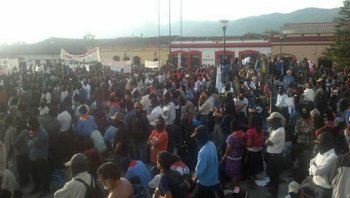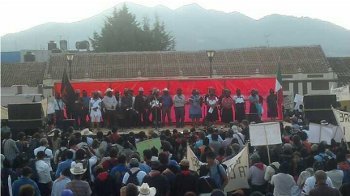
News

Mexico’s Drug War Victims Find Their Voice in Massive Silent March
| Source: Upside Down World |
| Written by Kristin Bricker |
| Tuesday, 10 May 2011 16:19 |
 Drug war victims finally made themselves heard in Mexico in the most unlikely way: a nation-wide silent March for Peace with Justice and Dignity.
Over 100,000 Mexicans took to the streets over the weekend to protest the war on drugs, impunity, corruption, and violence. The largest march lasted four days and covered nearly 100 kilometers from Cuernavaca, Morelos, to Mexico City. On Thursday, May 5, about 500 protesters began marching in Cuernavaca. Along the way, more contingents joined the march, while other marches set out from different states to join the protest in Mexico City. By the time the marches met in Mexico City’s main square on May 8, an estimated 100,000 people were gathered to protest the war.
Those who couldn’t make the trip to Mexico City held protests in their own states. In Chiapas, 25,000 masked Zapatistas marched in complete silence to the main plaza in San Cristobal de las Casas, where Comandante David read a communiqué from Subcomandante Marcos. “Tens of thousands of people have died in this absurd war,” said Comandante David. “Their only sin was to have been born or lived in a country that is badly governed by legal and illegal groups who are thirsty for war, death, and destruction.”
About seventy Central American migrants passing through Mexico to reach the United States also joined the March for Peace with Justice and Dignity. They marched along railroad tracks through Oaxaca, Veracruz, and Puebla, the route that migrants generally travel as they cling precariously to boxcars. Near the border between Veracruz and Puebla, armed men attempted to kidnap at least one woman during the march. The protesters don’t know if the attack was politically motivated, or just another example of the extreme violence migrants suffer daily as they travel through Mexico. Drug trafficking organizations frequently kidnap migrants for ransom or human trafficking. According to Eduardo Almeida of the Puebla-based Nodo human rights organization, the presence of reporters covering the march likely dissuaded the kidnappers in this case.
In Ciudad Juarez, about one thousand protesters marched in silence until they ran into the city’s mayor at the Benito Juarez monument. He fled the area on foot to avoid the protesters as they began chanting at him.
Protests occurred in all 31 states in Mexico. Protests were also reported in the United States, Canada, Europe, and South America. Mexican immigrants organized many of the protests that occurred in foreign cities.
“We Are Not Collateral Damage”
This weekend’s march, convoked by renowned Mexican writer Javier Sicilia after his son Juan Francisco was murdered in Morelos, allowed the drug war’s innocent victims to bring their stories to the national and international media, in many cases for the very first time. Prior to Sicilia’s public outrage over his son’s murder, the government stigmatized drug war murder victims, arguing that 90% of them are “cartel hit men.” Government agents have repeatedly doctored crime scenes and planted weapons on bodies to make innocent victims appear to be dangerous criminals. When the government does admit that innocent people have died in the drug war, it justifies the deaths as “collateral damage.”
However, from May 5-8, the drug war’s innocent victims stepped out of the shadows and into the international spotlight.
Many were meeting each other for the first time. When the marchers took breaks along Mexico’s 95D freeway, they sat down together to talk about their shared pain. Variations of the following exchange were frequently overheard during the march:
“Who is the young man in the photo you’re carrying?”
“He was my son. He was murdered. And who is the young man on your t-shirt?”
“He is my son. He’s disappeared.”
Some marchers lost family members within the past few months and had not yet politicized their search for answers; they were still in the initial stages of shock and desperation.
Carlos Castro marched with a 15-foot by 7-foot banner that pleaded “RETURN MY FAMILY TO ME” printed above photos of his missing wife, two daughters, and the family’s housekeeper. “I’m marching today to see if I can find my daughters,” Castro said as he choked back tears. The four women disappeared on January 6, 2011, from their home in Xalapa, Veracruz. Castro says he has no clue who took his family and housekeeper. “They entered [the house] and took the whole family. I’m doing this so that they [the kidnappers] receive this message and return them to me. I don’t know why they took them, they had no reason to take my daughters.” Castro’s wife Josefina Campillo Cerreto had just ended a stint as the Actopan (Veracruz) City Council’s trustee when the family was kidnapped. On December 13, 2010—just three weeks before the kidnapping—she updated her Facebook profile to list her job at the City Council and posted what would be her last status update: “I’d rather die fighting than give up without a fight.”
 Most marchers had at least a general idea of who disappeared or killed their family members. Surprisingly, protesters at the march against President Felipe Calderon’s drug war weren’t just limited to victims of military and police abuse. Victims of both organized and unorganized crime also marched against the war in large numbers.
Teresa, a middle-aged woman who lives in Morelos, marched with a photo of her son, Joaquin. “They killed him ten months ago in Mexico City,” she recounts. “I’m carrying his photo so that everyone knows who he was, sees that he had a face and a mother, just like the over 30,000 dead in this country. The dead aren’t just numbers. They were loved ones.” Joaquin was apparently murdered during a mugging. Teresa filed a report with the government, but the investigation, if there ever was one, went nowhere. As long as the investigation remains open, the government won’t let her cremate her son and spread his ashes in Cancun, where he was born. Joaquin is buried in a temporary grave in Morelos. The protests convoked by Javier Sicilia were the first time Teresa took to the streets to demand justice for her son. “I identify with Javier,” she says. “He was a young, productive, happy boy. Joaquin was beginning his third year of college, studying architecture. Joaquin was the type of young man this country needs, just like Juanelo [Javier’s son] was.”
Isaac Gomez Lopez, an art student who lives in Cuernavaca, argues, “A lot of people use the drug war as a pretext to attack other people. Now, it’s almost like anyone can kill someone and justify it by saying ‘it’s the drug war’ and it won’t be investigated. It just goes into a file.” Cuernavaca’s murder rate jumped after soldiers killed drug kingpin Arturo Beltran Leyva there in late 2009. Beltran Leyva’s death destabilized the territory his organization controlled, providing an opening for other organizations to move in an attempt a takeover, which inevitably led to more violence. “You start to see curfews, the streets empty because they’re not as safe,” says Gomez Lopez. “It’s really affecting tourism.”
Victims of organized crime marched against the war as well. “I’m a victim of human trafficking and organized crime,” declares Ivan Monroy Medina of the Regional Coalition Against Trafficking of Women and Girls. “Seven months ago they took my daughter. She was eleven months old and they violently took her from my wife in Mexico State.” Ramos says that human trafficking is a growing problem in his state. “There were meetings in the neighborhood where we were living. They warned us to be careful because a lot of children had been stolen from the neighborhood. Fifteen or twenty days later, it happened to us.” Monroy Medina and his wife reported the kidnapping to the authorities, “but since we don’t live in Predregal [an upscale neighborhood] and since we don’t know how to play golf and don’t know governors, they don’t pay any attention to us.”
Seven members of the LeBaron family drove down from the Mormon community of Colonia LeBaron, Chihuahua, to participate in the march. The LeBarons made international headlines in 2009 when they publicly refused to pay a million-dollar ransom for 16-year-old Erick LeBaron after he was kidnapped. “The kidnappers told Erick, ‘But there’s so many of you, can’t you all chip in and pay the ransom?’” recounts Adrian LeBaron, Erick’s uncle. The LeBarons feared that if they paid one exorbitant ransom, kidnappers would descend upon their community like vultures. Instead, Colonia LeBaron organized protests in Chihuahua City to demand that the government take action to bring Erick home. Their gamble worked; the kidnappers released Erick after seven days.
The LeBaron’s victory was short-lived. Only a few months later, a criminal organization punished Erick’s older brother Benjamin for organizing about fourteen local communities into an anti-kidnapping organization called SOS Chihuahua. “Twenty armed men went to his house and broke all his windows, and so his brother-in-law [Luis Widmar] came over to help him,” recounts Benjamin’s brother Julian. “They kidnapped them both and executed them about a mile down the road.”
Despite the fact that the LeBaron’s battle is with organized crime, Julian argues that his community’s problems started when President Calderon declared war on drugs. “The war on drugs has been a disaster for this country,” he insists.
Chihuahua, particularly Ciudad Juarez, is Mexico’s drug war “laboratory.” There, argues Proceso reporter Marcela Turati, “Not only drug traffickers, drug dealers, and even drug addicts, but also common citizens, above all youngsters, are involuntarily subjected to an experiment: how it would be, in Mexico, to live under military control.” A large contingent from Chihuahua participated in the March for Peace and Justice with Dignity to tell the president that the experiment has failed.
Maria Alvarado traveled all the way from Ciudad Juarez to participate in the march because the military disappeared her sister Nitza Paola Alvarado and cousins Rocío Irene Alvarado and José Ángel Alvarado on December 29, 2009, from Ejido Benito Juarez, where they were spending the holidays with family. “We tried to follow the them,” she recalls. “But it was very dark and they were taking them on back roads. We returned to the house because we were scared.” The military later left Nitza’s truck at a Chihuahua State Investigations Agency office without giving the local authorities any explanation as to why they were leaving it there.
The Alvarado family filed all of the necessary complaints with relevant government agencies, but they hit a brick wall. “The military has always said that there’s no indication that it was them, that they’ve never carried out operations in the town, which is a big lie,” insists Alvaro. “They stayed three weeks on the ejido in a hotel called Los Arcos, and they made rounds in the entire ejido.”
Regardless of who perpetrated the attacks on their families, all of the drug war victims in the march had the same demand: “We’re demanding that the authorities do their jobs,” says Alvarado. “All they do is create fat case files, and they don’t investigate.”
“They told us we had to take the legal route. ‘You have to go give your testimony and file your complaint and we’ll see if we get motivated to go chase the kidnappers,’” complains Adrian LeBaron. “We told them, ‘We don’t want to be another little paper in your mountains of files. We want our son.’ So we protested.”
A common slogan on signs and banners in the March for Peace with Justice and Dignity was directed at the authorities: “If you can’t do your job, then quit!”
National Pact for Peace
The movement to compel Mexican authorities to “do their jobs” and reduce the country’s staggering impunity rate doesn’t show any signs of letting up.
Javier Sicilia says that Zapatista spokesperson Subcomandante Marcos sent him a letter to tell him that the Zapatistas would join his march. The letter was hand-delivered and came with an oral message, too: “This march, this struggle, transcends the Left. This is a war against all of us, and all of us need to join together.”
“This is a struggle between those who want life and those who want death,” declared Comandante David during the Zapatistas’ march in Chiapas. “And we, the Zapatistas, we chose to struggle for life—that is, for justice, liberty, and peace.”
On May 8 in front of about 100,000 people, Olga Reyes, who has lost six family members in the drug war, and Patricia Duarte, whose son Andrés died in a fire at the ABC Daycare due to government negligence, read the proposal for a National Pact for Peace, a citizens initiative to reduce violence, corruption, and impunity in Mexico. The pact has six central demands:
The proposal will be finalized and signed during a public event on June 10 in Ciudad Juarez, the deadliest city in the world.
|





